Read and report vaccine reactions, harassment and failures.

Rubella is a respiratory illness caused by a togavirus, genus Rubivirus. While often referred to as “German measles” or “three-day measles”, this virus is different and not related to the virus that causes measles. Rubella is contagious and is transmitted through direct contact or contact with respiratory secretions (nasal discharge, coughing, sneezing). Persons with rubella are most contagious when the rash first appears but can be contagious for seven days prior to seven days after symptoms appear. In the U.S. and other temperate climates, rubella is usually seen in late winter and early spring. Prior to the introduction of vaccines targeting rubella, epidemics of the illness generally occurred every six to nine years.
Laboratory testing is needed to confirm a diagnosis of rubella because the rash associated with the illness is not easily distinguishable from other rash illnesses. Secretions from the nose and throat as well as urine and blood can be tested to confirm a diagnosis of rubella. There are 12 confirmed (1B, 1C, 1D, 1E, 1F, 1G, 1H, 1I, 1J, 2A, 2B, 2C) and 1 provisional (1a) rubella genotypes which belong to 2 distinct clades. Genotypes 1E, 1G, 1J, and 2B are the most commonly circulating genotypes.
The rubella virus is easily destroyed by ultraviolet light, low pH, amantadine, lipid solvents, trypsin, formalin, and heat.
Rubella Symptoms
In children, the first sign of illness is usually a rash that appears on the face then spreads towards the feet. Non-specific symptoms that may occur one to five days before the appearance of the rash include a cough, runny nose, generalized discomfort, headache, low-grade fever, enlarged lymph nodes and swelling or redness to the whites of the eyes. Symptoms in adults are generally like those experienced by children but up to 70 percent of women may experience arthritis or arthralgia that may be persistent. Rare complications of rubella include encephalitis (brain inflammation) and thrombocytopenia purpura (blood clotting disorder). Up to 50 percent of people with rubella will have no symptoms.
Rubella in Pregnancy
Rubella is most serious when it occurs in women during their first trimester of pregnancy. Women who develop rubella during this time are at a high risk of miscarriage, still birth, and of giving birth to an infant with congenital rubella syndrome (CRS).
Infants with CRS can have multiple health issues affecting nearly all organs of the body, including deafness, vision impairments, cardiac defects, microcephaly, neurological abnormalities, developmental delays, and more. Up to 85 percent of infants exposed to rubella in the first 8 weeks of fetal development are at risk for CRS. By 12 weeks, the risk decreases to 50 percent and by 20 weeks, the risk is essentially zero.
IMPORTANT NOTE: NVIC encourages you to become fully informed about Rubella and the Rubella vaccine by reading all sections in the Table of Contents, which contain many links and resources such as the manufacturer product information inserts, and to speak with one or more trusted health care professionals before making a vaccination decision for yourself or your child. This information is for educational purposes only and is not intended as medical advice.



